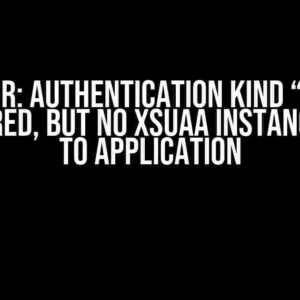Are you scratching your head, wondering why your Lambda function isn’t firing off as many concurrent executions as you’d like? You’re not alone! In this article, we’ll dive into the most common reasons behind this frustrating phenomenon and provide you with actionable tips to get your Lambda function running at peak concurrency.
- The Mysterious Case of the Missing Concurrency
- Limits and Throttling: The Obvious Culprits
- Function Duration and Memory: The Hidden Bottlenecks
- Event Source Mapping and Invocation Types: The Overlooked Factors
- VPC Configuration and SecurityGroups: The Network Bottlenecks
- Monitoring and Troubleshooting: The Key to Concurrency Success
- The Road to Concurrency Nirvana
The Mysterious Case of the Missing Concurrency
Before we dive into the solutions, let’s set the stage. You’ve crafted a brilliant Lambda function, and you’re expecting it to handle a high volume of requests with ease. But, when you check your CloudWatch metrics, you notice that the concurrency is stuck at a paltry few executions. What’s going on?!
The first step in solving this puzzle is to understand how Lambda concurrency works. In a nutshell, AWS Lambda allows your function to process multiple events concurrently, up to a maximum of 1000 executions per account per region. However, there are several factors that can limit this concurrency, and we’ll explore those next.
Limits and Throttling: The Obvious Culprits
The most obvious reason for limited concurrency is hitting the account-level or function-level concurrency limits. If you’ve reached the maximum allowed executions, Lambda will simply throttle your function, preventing it from running more concurrent executions.
To check your account-level limits, head to the AWS Lambda dashboard and navigate to the “Concurrency” tab. If you’re hitting the limit, you can request a limit increase by submitting a support ticket.
Function-level limits are a bit more nuanced. By default, each Lambda function has a concurrency limit of 1000. However, you can adjust this limit by setting the `ReservedConcurrentExecutions` property in your function’s configuration.
aws lambda update-function-configuration \
--function-name your-function-name \
--reserved-concurrent-executions 500
Be cautious when increasing your function-level limits, as this can lead to increased costs and potential performance issues.
Function Duration and Memory: The Hidden Bottlenecks
Another common reason for limited concurrency is related to function duration and memory usage. When your Lambda function takes too long to complete or consumes too much memory, it can prevent other executions from running concurrently.
The rule of thumb is to keep your function duration under 100ms and memory usage below 128MB. This allows Lambda to efficiently manage resources and enable higher concurrency.
| Duration (ms) | Memory (MB) | Concurrency Impact |
|---|---|---|
| < 100 | < 128 | Higher concurrency possible |
| > 100 | >& 128 | Lower concurrency possible |
To optimize your function’s duration and memory usage, focus on:
- Code optimization: Simplify your code, reduce complexity, and avoid unnecessary computations.
- Caching: Implement caching mechanisms to reduce the load on your function and external services.
- Database queries: Optimize database queries to reduce latency and resource usage.
Event Source Mapping and Invocation Types: The Overlooked Factors
Event source mapping and invocation types can also impact concurrency. If your function is triggered by an event source, such as an S3 bucket or DynamoDB table, the event source mapping can limit concurrency.
For example, if you’re using an S3 bucket as an event source, ensure that the bucket is configured to send events in parallel. You can do this by setting the `Event` property to `synchronous` when creating the event source mapping.
aws lambda create-event-source-mapping \
--function-name your-function-name \
--event-source-arn arn:aws:s3:::your-bucket \
--event s3:ObjectCreated:* \
--enabled
Invocation types, such as `RequestResponse` or `Event`, can also affect concurrency. `RequestResponse` invocations are synchronous and block the execution of other events, whereas `Event` invocations are asynchronous and allow for higher concurrency.
aws lambda invoke \
--function-name your-function-name \
--invocation-type Event \
--payload '{"key": "value"}'
VPC Configuration and SecurityGroups: The Network Bottlenecks
VPC configuration and security groups can also limit concurrency. If your Lambda function is running within a VPC, ensure that the security groups and network ACLs allow for sufficient incoming and outgoing traffic.
Failing to configure your VPC correctly can lead to connection timeouts, errors, and reduced concurrency.
Double-check your VPC configuration, and ensure that:
- Your security group allows incoming traffic on the necessary ports.
- Your network ACLs allow traffic to flow between subnets.
- Your Lambda function has a sufficient number of available IP addresses.
Monitoring and Troubleshooting: The Key to Concurrency Success
Monitoring and troubleshooting are crucial to identifying and resolving concurrency issues. Use CloudWatch metrics and logs to monitor your function’s performance and identify bottlenecks.
Focus on metrics such as:
- ConcurrentExecutions: The number of concurrent executions of your Lambda function.
- Duration: The average time it takes for your function to complete.
- ErrorCount: The number of errors occurring during function executions.
Use the AWS X-Ray service to gain deeper insights into your function’s performance and identify areas for optimization.
aws xray get-tracing-config \
--resource-arn arn:aws:lambda:REGION:ACCOUNT_ID:function:FUNCTION_NAME
The Road to Concurrency Nirvana
In conclusion, achieving high concurrency in AWS Lambda requires attention to detail, careful planning, and continuous monitoring. By understanding the factors that limit concurrency and implementing the solutions outlined in this article, you’ll be well on your way to unlocking the full potential of your Lambda function.
Remember to keep your function duration and memory usage in check, optimize your event source mapping and invocation types, and configure your VPC correctly. Don’t forget to monitor and troubleshoot regularly to ensure your function is running at peak concurrency.
Now, go forth and conquer the world of Lambda concurrency!
Did you find this article helpful? Share your concurrency success stories and challenges in the comments section below!
Stay tuned for more AWS Lambda tutorials and insights on our blog!
Frequently Asked Question
Are you stuck in a tricky situation where your Lambda function is not running concurrently as expected? Don’t worry, we’ve got you covered!
Why is my Lambda function not running multiple concurrent executions?
One common reason for this is that you haven’t configured your Lambda function to allow concurrent executions. By default, Lambda functions are set to run one execution at a time. To enable concurrent executions, you need to set the ‘Reserved Concurrency’ value to a number greater than 0. This value determines how many concurrent executions your function can handle.
Is it possible that my function is not handling async requests correctly?
Yes, it’s possible! If your Lambda function is not designed to handle asynchronous requests, it might not be able to handle concurrent executions. Make sure your function is written to handle async requests and returns a response quickly, allowing Lambda to invoke the function again.
Could my function’s execution time be the culprit?
That’s a great point! If your Lambda function takes a long time to execute, it might not be able to handle concurrent executions. Lambda has a maximum execution time limit of 15 minutes. If your function is close to or exceeds this limit, it might not be able to handle concurrent invocations. Optimize your function’s performance to reduce its execution time.
Are there any account-level limitations that could be affecting my function?
Yes, there are account-level limitations that could be affecting your Lambda function’s concurrent executions. Check if you’ve reached the account-level concurrency limit (/default limit is 1000). You can request a limit increase by submitting a support ticket to AWS. Additionally, check if you’ve reached the account-level throttle limit (default limit is 1000 per account per region). You can request a throttle limit increase by submitting a support ticket to AWS.
Could my function’s configuration or resources be limiting its concurrency?
Yes, it’s possible! If your Lambda function is configured to use too few resources (e.g., memory, CPU), it might not be able to handle concurrent executions. Check your function’s configuration and adjust the resource allocation as needed. Additionally, ensure that your function doesn’t have any bottlenecks in its code that could limit concurrency.


